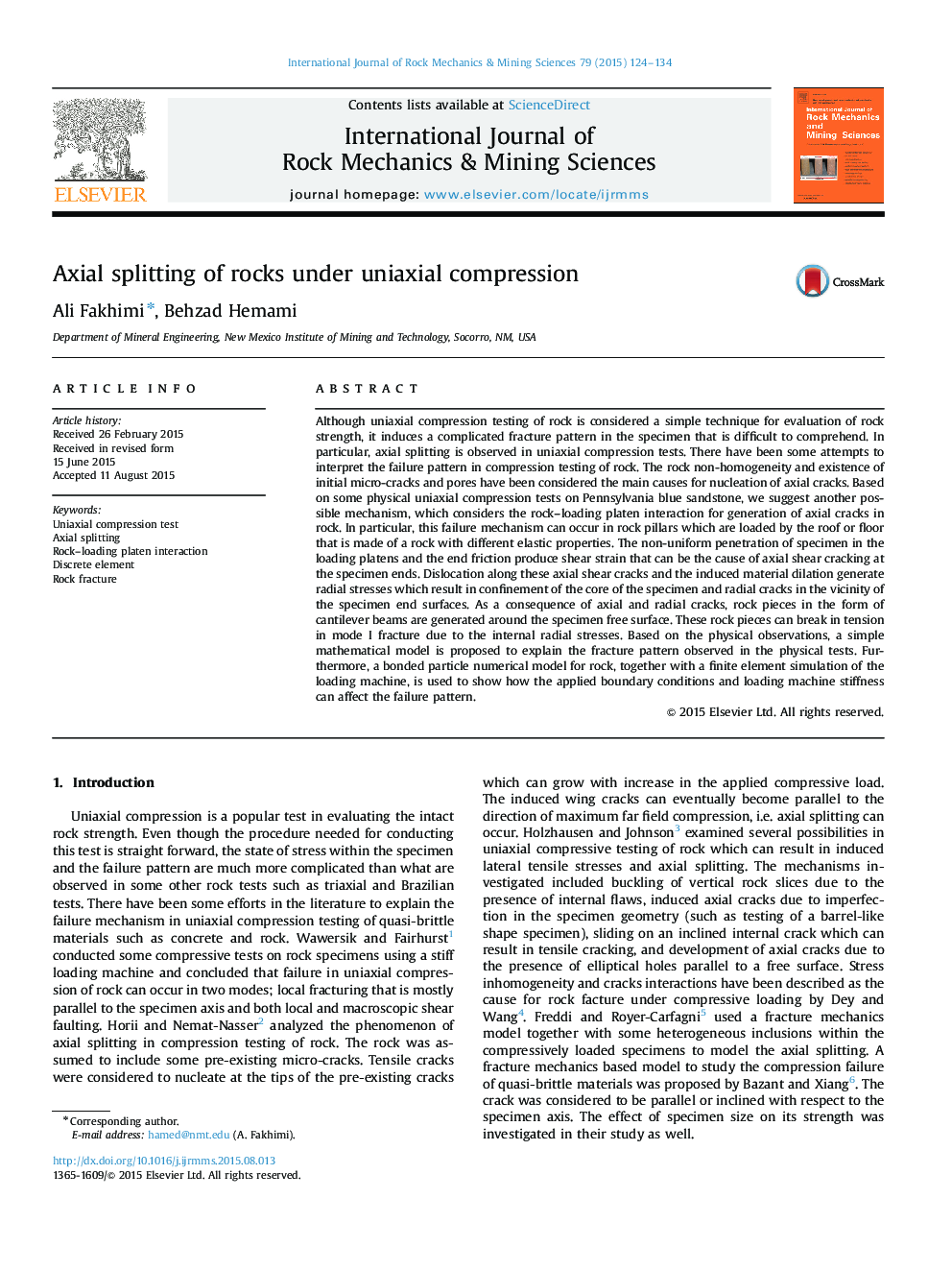| کد مقاله | کد نشریه | سال انتشار | مقاله انگلیسی | نسخه تمام متن |
|---|---|---|---|---|
| 7206480 | 1468690 | 2015 | 11 صفحه PDF | دانلود رایگان |
عنوان انگلیسی مقاله ISI
Axial splitting of rocks under uniaxial compression
ترجمه فارسی عنوان
تقسیم محوری سنگها تحت فشرده سازی یکنواخت
دانلود مقاله + سفارش ترجمه
دانلود مقاله ISI انگلیسی
رایگان برای ایرانیان
کلمات کلیدی
ترجمه چکیده
اگر چه تست تراکم یکنواختی سنگ به عنوان یک روش ساده برای ارزیابی قدرت سنگ مورد استفاده قرار می گیرد، الگوی شکستگی پیچیده ای را در نمونه ایجاد می کند که دشوار است. به طور خاص، تقسیم محوری در آزمایش فشرده سازی یکسانی مشاهده می شود. برخی از تلاش ها برای تفسیر الگوی شکست در آزمایش فشرده سازی سنگ صورت گرفته است. غیرهمگن بودن سنگ و وجود ترکیبات و منافذ اولیه به عنوان عامل اصلی ایجاد ترک های محوری مورد توجه قرار گرفته است. بر اساس برخی از تست های فشرده سازی فشرده ی یک طرفه در ماسه سنگ آبی پنسیلوانیا، ما پیشنهاد می کنیم که یکی دیگر از مکانیسم های احتمالی است که تعامل پلت فرم سنگ را برای تولید ترک های محوری در سنگ بررسی می کند. به طور خاص، این مکانیسم شکست می تواند در ستون های سنگی رخ دهد که توسط سقف و کف ساخته شده از یک سنگ با خواص الاستیک مختلف ساخته شده است. نفوذ غیر یکنواخت نمونه در پانل های بارگذاری و اصطکاک پایان باعث ایجاد فشار برشی می شود که می تواند باعث ایجاد ترک خوردگی محوری در انتهای نمونه شود. جابجایی در امتداد این ترکهای محوری برشی و کشش مواد القا شده باعث ایجاد تنشهای شعاعی می شود که منجر به محو شدن هسته نمونه و ترک های شعاعی در مجاورت سطوح انتهایی نمونه می شود. به عنوان یک نتیجه از ترک های محوری و شعاعی، قطعات سنگی به شکل پرتوهای کانتینری در اطراف سطح آزاد نمونه ایجاد می شود. این قطعات سنگ می تواند به علت تنش های شعاعی داخلی در تنش در حالت من شکسته شود. بر اساس مشاهدات فیزیکی، یک مدل ریاضی ساده برای توضیح الگوی شکستگی مشاهده شده در آزمایش های فیزیکی پیشنهاد شده است. علاوه بر این، یک مدل عددی ذرات پیوندی برای سنگ، همراه با یک شبیه سازی عنصر محدود از دستگاه بارگیری، برای نشان دادن چگونگی شرایط مرزی اعمال شده و سفتی دستگاه بارگیری می تواند بر الگوی شکست تاثیر بگذارد.
موضوعات مرتبط
مهندسی و علوم پایه
علوم زمین و سیارات
مهندسی ژئوتکنیک و زمین شناسی مهندسی
چکیده انگلیسی
Although uniaxial compression testing of rock is considered a simple technique for evaluation of rock strength, it induces a complicated fracture pattern in the specimen that is difficult to comprehend. In particular, axial splitting is observed in uniaxial compression tests. There have been some attempts to interpret the failure pattern in compression testing of rock. The rock non-homogeneity and existence of initial micro-cracks and pores have been considered the main causes for nucleation of axial cracks. Based on some physical uniaxial compression tests on Pennsylvania blue sandstone, we suggest another possible mechanism, which considers the rock-loading platen interaction for generation of axial cracks in rock. In particular, this failure mechanism can occur in rock pillars which are loaded by the roof or floor that is made of a rock with different elastic properties. The non-uniform penetration of specimen in the loading platens and the end friction produce shear strain that can be the cause of axial shear cracking at the specimen ends. Dislocation along these axial shear cracks and the induced material dilation generate radial stresses which result in confinement of the core of the specimen and radial cracks in the vicinity of the specimen end surfaces. As a consequence of axial and radial cracks, rock pieces in the form of cantilever beams are generated around the specimen free surface. These rock pieces can break in tension in mode I fracture due to the internal radial stresses. Based on the physical observations, a simple mathematical model is proposed to explain the fracture pattern observed in the physical tests. Furthermore, a bonded particle numerical model for rock, together with a finite element simulation of the loading machine, is used to show how the applied boundary conditions and loading machine stiffness can affect the failure pattern.
ناشر
Database: Elsevier - ScienceDirect (ساینس دایرکت)
Journal: International Journal of Rock Mechanics and Mining Sciences - Volume 79, October 2015, Pages 124-134
Journal: International Journal of Rock Mechanics and Mining Sciences - Volume 79, October 2015, Pages 124-134
نویسندگان
Ali Fakhimi, Behzad Hemami,
